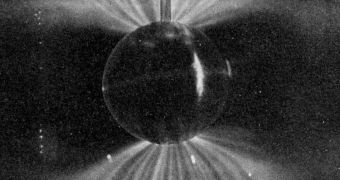As evidenced decades ago, Earth is surrounded by a couple of radiation belts, atmospheric structures that contain large amounts of dangerous charged electrons. Some experts suggested that increased solar activity might be capable of driving them towards the surface, but new data shows that to be false.
Researchers determined that the highly-charged electrons making their way through Earth's Van Allen radiation belts would not be redirected towards the planet, when the Sun reached the peak of its current cycle, in 2013.
Some solar physicists suggested a while back that intense coronal mass ejections and solar flare could have the ability to pull the killer electrons out of their radiation belts, and then redirect them towards Earth. If that were the case, then life here would have been threatened.
But the new data show that an increase in space weather intensity will cause no such effects. On the contrary, more solar particles around Earth will guide the dangerous electrons away from the planet.
The new study was based on readings collected by 11 independent spacecraft. The work was led by University of California in Los Angeles (UCLA) expert Drew Turner. The NASA Themis satellite constellation and two NOAA/EOEMS spacecraft were among the assets used for data-collection.
Details of the analysis appear in the January 29 issue of the top scientific journal Nature Physics, Space reports.
Such investigations were first triggered by observations conducted on the Van Allen radiation belts, which revealed temporary dropouts in killer electron levels. Where the particles are going was a matter of debate for many years.
Furthermore, analyses also revealed that these dropouts could occur frequently, up to several times per month. Only two scenarios were possible – one in which the particles were directed towards, and absorbed by, the atmosphere, and another in which they were cast towards outer space.
The latest research revealed that killer electrons were allowed to escape to space during these dropouts, which means that we are safe. While this implies that the Van Allen belts are depleted during these events, researchers assure us that the very solar winds doing the depleting are also resupplying the belts with additional charged material.
Additional details on how this mechanism works will be obtained once NASA launches its Radiation Belt Storm Probes Mission (RBSP), this August. “RBSP will provide two more points of view with perfect instruments for radiation belt studies,” Turner concludes.

 14 DAY TRIAL //
14 DAY TRIAL //